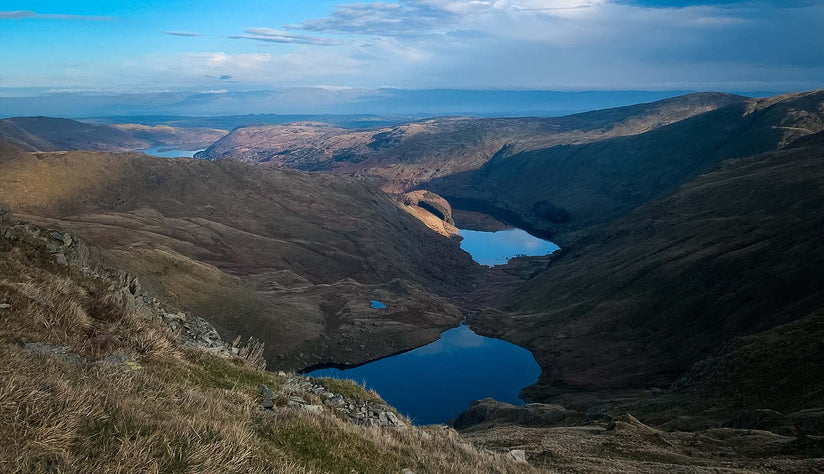A base layer is an essential part of any enthusiastic adventurer’s layering system, especially during the changing seasons. Just read our dedicated page to learn more about how you can layer like a pro this spring.
By far the most popular base layers at Montane are the Dart range. It’s not hard to see why these extremely lightweight and breathable base layers get so much good feedback. Not only do they keep you comfortable whilst on the move, our summer Dart range also uses 100% APEX ECO fabric (a recycled polyester). The only exception to this are the Dart Thermo products, including the Dart Thermo Zip Neck, which uses 12% elastane, to allow a little extra stretch for even more movement.
We originally launched our Dart range many years ago using virgin polyester, but as we’ve made steps to reduce our environmental impact, we are proud to have now transitioned this range so that these popular base layers are made with recycled polyester. This includes new lightweight styles, the Dart Lite and Dart Nano, which have been engineered with fast and light activities in warmer conditions in mind. As of 2023, our Dart Zip Neck T-Shirts now also use recycled zip tapes.
Eager to undertand more? Keep reading to discover the journey from plastic bottle to base layer…
A brief overview of Polyester
So we can’t talk about recycled polyester without giving you some more insight into the original virgin polyester! In a nutshell, polyester is a synthetic man-made fiber also known as PET (if you want to get really nerdy, it’s chemical name is Polyethylene Terephthalate), and recycled polyester is rPET, for those curious.
Virgin polyester is usually derived from oil. The process of development is complex and has multiple stages (keep reading to learn more about this!). Polyester manufacturing creates a variety of fabrics, used in many different products, including clothing, accessories, furnishings and electronics.
One of the major benefits of polyester is its ability to not absorb water and other oils - this means it dries quickly and doesn’t stain easily. As a result, it is an ideal option for outdoor clothing which, as we know, needs to work hard in outdoor environments where it is exposed to many elements.
From plastic bottle to base layer
As previously mentioned, the development of fabric is a complex process, so we want to share a breakdown in simple terms. First things first, the creation of all fabric starts with a raw material. In the case of mechanically recycled polyester, this begins its life as post-consumer plastic bottles. It is the raw materials used which form the main difference between virgin and recycled polyester.
The used plastic bottles come from recycling centres which, once collected, are sorted according to whether they’re clear or coloured. This is because coloured bottles are hard to dye - so we wouldn’t be able to give you the great Montane colours we know and love! The clear bottles go on to be thoroughly cleaned (with leftover liquid and stickers removed), before being chopped and flaked into small pieces.
Although there is water and energy used to sort, wash and flake plastic bottles, this is lower than the water and energy that goes into raw material (oil) extraction and processing. Ultimately, this reduces the resources used and the greenhouse gas emissions generated.
From here, the process is almost like-for-like with how virgin polyester is created. For those unfamiliar, a series of machines turn the flakes into plastic pellets, which are then melted and turned into yarn (and dyed different colours) before finally transforming into the range of Dart base layers you can find on our website.

How is APEX ECO more sustainable?
In short, utilising recycled polyester fabrics in our Dart base layer range is a better option for the planet than virgin polyester. Not only does it reduce our reliance on finite, unsustainable resources, such as oil, we’re also able to help reduce plastic waste.
Want to know exactly how many bottles are recycled as part of this process? The Dart range includes a variety of styles and each one utilises varying amounts of yarn (and as a result plastic bottles) in its development. Whilst the smaller Dart gloves use just 1 bottle, the Dart Long Sleeve-T-shirt takes this up to 9…and a pair of Long Johns 7! The overall impact of this means for our spring summer 23 Dart range, we have saved approximately 534,526 bottles from going to landfill.
Montane’s progression to using recycled polyester in the Dart series is a step in the right direction. But we know there is more to be done to ensure overall production of fabrics we use is more environmentally friendly, and that we have a responsibility to strive to be better. We also acknowledge that rPET is dependent on a feedstock which is ultimately dependent on fossil fuel extraction and that, as rates of recycling for plastic bottles increase, availability of that feedstock will become more limited.
Rest assured, we are committed to continuing to explore progressive technologies as they become available at scale and without limitations to cost, colour and quality. Montane’s journey towards more sustainable fabrics is ever evolving!
Additional benefits of the Dart base layer
Did you know that washing and drying accounts for two thirds of the environmental impact of an item of clothing? As a base layer sits next to your skin, it is naturally exposed to a high level of sweating.
The good news about Dart base layers is that they are treated with Polygiene® which has antimicrobial properties that help prevent odor-causing bacteria from developing. The benefits of this are that you don’t have to wash these items as often - saving water and energy - as well as improving the lifespan of your base layer.
Polygiene is also bluesign® approved which means it’s been manufactured in a way that is safe for the environment, the workers and also those who will be wearing the clothing it’s been treated with. Find out more about how Polygiene works on our fabric technology page.
















